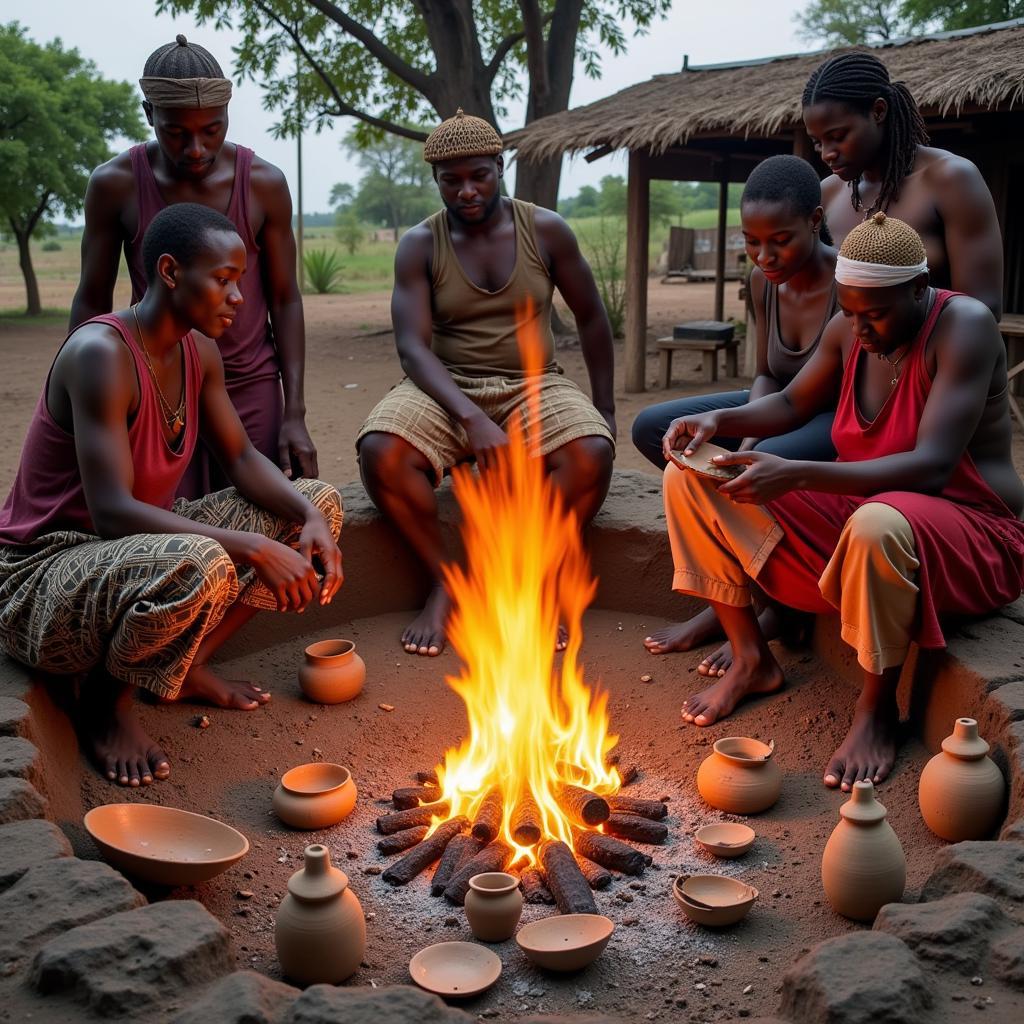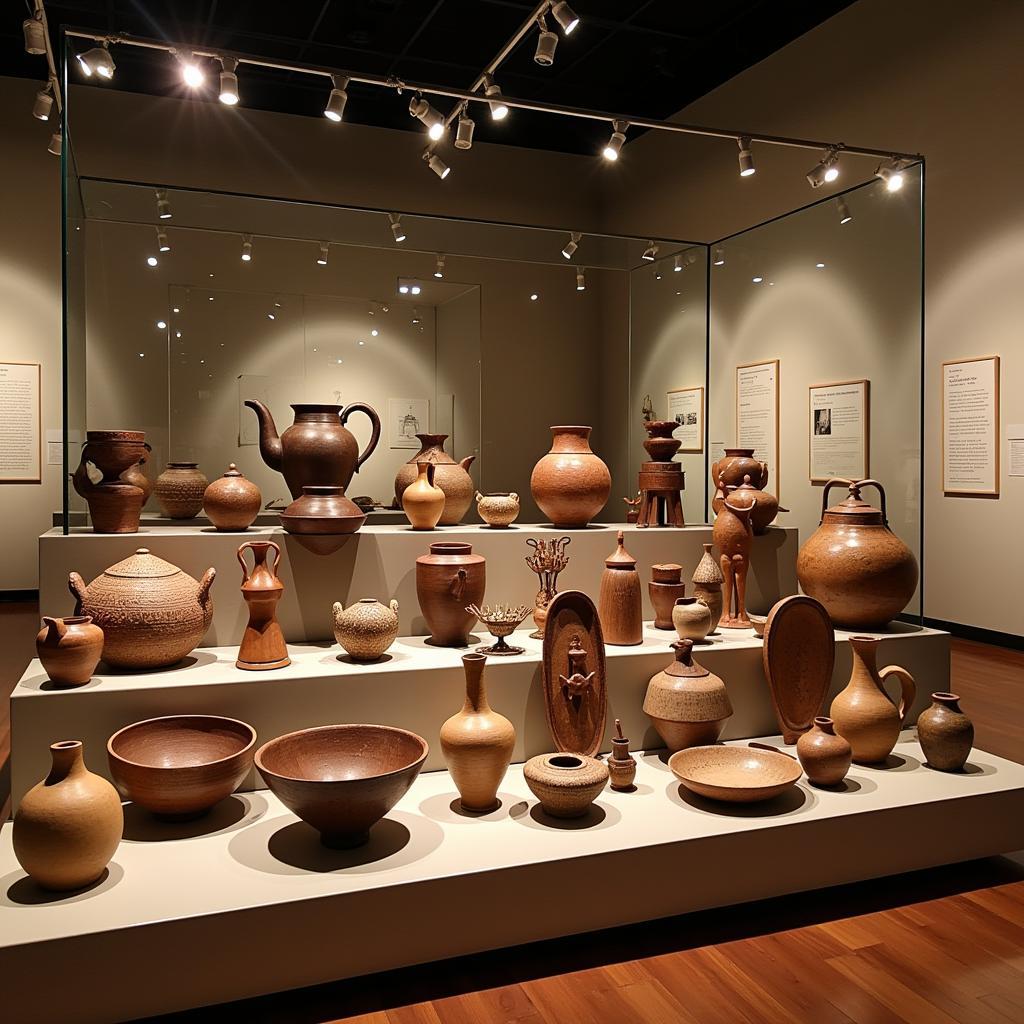Exploring the Diverse World of African Ceramics
African Ceramics, a vibrant expression of creativity and cultural heritage, have captivated art enthusiasts and collectors for centuries. From the intricate patterns of North African pottery to the bold sculptures of West Africa, the continent boasts a rich tapestry of ceramic traditions. This article delves into the fascinating world of African ceramics, exploring their history, techniques, and significance in various cultures.
A Journey Through Time: The History of African Ceramics
Archaeological evidence suggests that pottery making in Africa dates back thousands of years. In regions like Egypt and Sudan, ancient civilizations developed sophisticated techniques for creating functional and decorative ceramic wares. The discovery of terracotta figurines, such as the Nok sculptures of Nigeria, provides valuable insights into the artistic sensibilities and belief systems of early African societies.
 Ancient African Ceramics
Ancient African Ceramics
Diverse Styles and Techniques: From Utilitarian Wares to Exquisite Art
African ceramics encompass a wide spectrum of forms, functions, and aesthetics. While some communities specialize in utilitarian pottery for everyday use, others excel in crafting ceremonial objects, sculptures, and decorative pieces.
The Art of Hand-Building: Shaping Tradition
Hand-building techniques, often passed down through generations, remain prevalent across Africa. Coiling, pinching, and slab building are just a few methods employed to shape clay into desired forms. The use of local materials, such as clay sourced from riverbeds or specific regions, contributes to the unique character and textures of African ceramics.
Firing in Open Pits: Embracing the Elements
Traditional firing methods, often involving open pits or bonfires, impart distinct qualities to African ceramics. The intensity and duration of the firing process influence the final color, texture, and durability of the pieces. Some communities utilize specific woods or plant materials to achieve desired effects, further connecting their ceramics to the surrounding environment.
 African Ceramic Firing Techniques
African Ceramic Firing Techniques
Beyond Functionality: The Cultural Significance of African Ceramics
African ceramics extend far beyond their utilitarian purposes, serving as powerful symbols of cultural identity, spirituality, and social customs.
Ritualistic Vessels: Connecting to the Divine
In many African cultures, ceramic vessels play integral roles in religious ceremonies and spiritual practices. Elaborately decorated pots are used to store offerings, libations, or ceremonial objects, connecting the material and the spiritual realms.
Symbols of Status and Identity: Expressing Social Hierarchies
The ownership and display of certain types of African ceramics can signify social status, wealth, or lineage. Intricately patterned pots, for instance, may be passed down through generations as heirlooms, embodying family history and cultural continuity.
 African Ceramics: Cultural Significance
African Ceramics: Cultural Significance
African Ceramics Today: A Fusion of Tradition and Innovation
Contemporary African ceramic artists continue to draw inspiration from their rich heritage while embracing innovation and experimentation. Many artists incorporate modern designs, materials, and techniques, pushing the boundaries of traditional forms and creating unique expressions. The global recognition and appreciation for African art have provided new platforms for these artists to showcase their talent and share their cultural narratives with the world.
Conclusion
African ceramics offer a captivating glimpse into the continent’s diverse cultures, artistic ingenuity, and historical depth. From ancient terracotta figures to contemporary ceramic sculptures, these art forms embody the spirit of Africa, bridging the past and the present. As we admire the beauty and craftsmanship of African ceramics, we are reminded of the enduring power of art to connect us across cultures and generations.
FAQs
What are some of the most famous types of African ceramics?
Some renowned types include Moroccan pottery with its intricate geometric designs, Nigerian Igbo-Ukwu bronzes known for their exquisite detail, and the pottery of the Konso people of Ethiopia, celebrated for its minimalist aesthetic.
Where can I find authentic African ceramics?
You can find authentic African ceramics at reputable art galleries, cultural centers, and online marketplaces specializing in African art. Visiting local markets and craft shops during your travels to Africa can also offer unique opportunities to discover and purchase these treasures.
Are there any ethical considerations when buying African ceramics?
It’s crucial to ensure that the purchase of African ceramics supports fair trade practices and benefits local artisans. Look for ethical sourcing certifications or purchase directly from reputable dealers committed to ethical sourcing.
How can I learn more about African ceramic traditions?
Numerous books, documentaries, and online resources delve into the rich history and techniques of African ceramics. You can also visit museums with African art collections or attend exhibitions and workshops dedicated to this art form.
What is the future of African ceramics?
African ceramics continue to evolve and captivate audiences worldwide. Contemporary artists are pushing boundaries, experimenting with new materials and techniques, and gaining international recognition. The future of African ceramics is bright, promising continued innovation and a celebration of the continent’s artistic legacy.
Explore Further
Interested in learning more about African art and culture? Check out these related articles:
Need assistance or have questions? Contact us at:
Phone: +255768904061
Email: kaka.mag@gmail.com
Address: Mbarali DC Mawindi, Kangaga, Tanzania
We have a dedicated customer support team available 24/7 to assist you.
